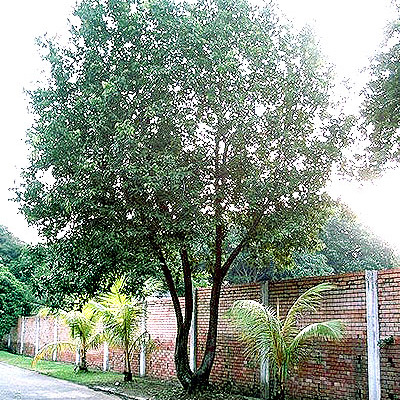Trees, up to 20 m tall, to 20 cm d.b.h. Branches always opposite, robust; branchlets terete or obtusely tetragonous, dark brown when dry, densely puberulent initially but soon glabrate. Buds small, ovoid; bud scales densely sericeous. Leaves subopposite; petiole red-brown, robust, 1-3 cm, ± densely pubescent; leaf blade opaque yellow-green abaxially, shiny green adaxially, ovate or elliptic, 12-35 × 5.5-8.5 cm, thickly leathery, densely pubescent initially soon glabrate but not glabrous abaxially, glabrous adaxially, trinerved or triplinerved, basal lateral veins arising at or up to 10 mm above leaf base, basal lateral veins and midrib elevated on both surfaces, transverse veins and veinlets slightly conspicuous on both surfaces or inconspicuous adaxially and ± visible abaxially, base broadly cuneate to subrounded, apex obtuse or emarginate. Panicles axillary or terminal, solitary or ternate, 6-26 cm, several branched; branches 1-2.5(-6) cm, apex bearing a 3-7-flowered cyme; peduncles 3-10(-15) cm, peduncle and rachis densely pubescent. Pedicels 2.5-5 mm, densely gray pubescent. Flowers greenish, 4-5(-6) mm. Perianth densely gray pubescent outside and inside; perianth tube obconical, 1-2 mm; perianth lobes 6, acute, outer ones ovate-oblong, ca. 4 × 2 mm, inner ones oblong, narrower, ca. 4 × 1.5 mm. Fertile stamens 9, ca. 3 mm (of 1st and 2nd whorls) or ca. 3.6 mm (of 3rd whorl); filaments villous, those of 3rd whorl each with 2 orbicular glands near base, others glandless; anthers of 1st and 2nd whorls ovate-oblong, nearly as long as filaments, each with 4 introrse cells, those of 3rd whorl oblong, narrower, ca. 1.5 mm, slightly shorter than filaments, each with 4 extrorse cells. Staminodes 3, conspicuous, sagittate-triangular, ca. 2.3 mm, long stalked. Ovary ovoid, ca. 1.5 mm; style slender, ca. 3 mm; stigma discoid, lobed. Fruit ovoid, 9-10(-12) × ca. 7 cm, apiculate, greenish or green when fresh; perianth cup in fruit obconical or bowl-shaped, slightly dilated, up to 8 mm wide, with somewhat dilated or patent persistent lobes at apex; fruit stalk somewhat thickened. Fl. Mar-Apr, fr. May-Jun.
More
A large tree. It grows to 20 m high. The trunk can be 20 cm across. The leaves are opposite, smooth and leathery. The leaf blades are 12-35 cm long by 5.5-8.5 cm wide. New flushes of leaves follow rain and are reddish pink. They are rounded at the base and taper to the tip. The flowers are yellowish and borne in compound flower clusters. The fruit is oval. It is 10 cm long by 7 cm wide. It is greenish when fresh.


